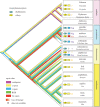Eye evolution: common use and independent recruitment of genetic components
- PMID: 19720647
- PMCID: PMC2781861
- DOI: 10.1098/rstb.2009.0079
Eye evolution: common use and independent recruitment of genetic components
Abstract
Animal eyes can vary in complexity ranging from a single photoreceptor cell shaded by a pigment cell to elaborate arrays of these basic units, which allow image formation in compound eyes of insects or camera-type eyes of vertebrates. The evolution of the eye requires involvement of several distinct components-photoreceptors, screening pigment and genes orchestrating their proper temporal and spatial organization. Analysis of particular genetic and biochemical components shows that many evolutionary processes have participated in eye evolution. Multiple examples of co-option of crystallins, Galpha protein subunits and screening pigments contrast with the conserved role of opsins and a set of transcription factors governing eye development in distantly related animal phyla. The direct regulation of essential photoreceptor genes by these factors suggests that this regulatory relationship might have been already established in the ancestral photoreceptor cell.
Figures




Similar articles
-
New perspectives on eye development and the evolution of eyes and photoreceptors.J Hered. 2005 May-Jun;96(3):171-84. doi: 10.1093/jhered/esi027. Epub 2005 Jan 13. J Hered. 2005. PMID: 15653558
-
New perspectives on eye evolution.Curr Opin Genet Dev. 1995 Oct;5(5):602-9. doi: 10.1016/0959-437x(95)80029-8. Curr Opin Genet Dev. 1995. PMID: 8664548 Review.
-
Reconstructing the eyes of Urbilateria.Philos Trans R Soc Lond B Biol Sci. 2001 Oct 29;356(1414):1545-63. doi: 10.1098/rstb.2001.0971. Philos Trans R Soc Lond B Biol Sci. 2001. PMID: 11604122 Free PMC article. Review.
-
Evolution of Insect Color Vision: From Spectral Sensitivity to Visual Ecology.Annu Rev Entomol. 2021 Jan 7;66:435-461. doi: 10.1146/annurev-ento-061720-071644. Epub 2020 Sep 23. Annu Rev Entomol. 2021. PMID: 32966103 Review.
-
Coexpression of two visual pigments in a photoreceptor causes an abnormally broad spectral sensitivity in the eye of the butterfly Papilio xuthus.J Neurosci. 2003 Jun 1;23(11):4527-32. doi: 10.1523/JNEUROSCI.23-11-04527.2003. J Neurosci. 2003. PMID: 12805293 Free PMC article.
Cited by
-
Modelling the evolution of novelty: a review.Essays Biochem. 2022 Dec 8;66(6):727-735. doi: 10.1042/EBC20220069. Essays Biochem. 2022. PMID: 36468669 Free PMC article.
-
Particulate Matter Induced Adverse Effects on Eye Development in Zebrafish (Danio rerio) Embryos.Toxics. 2024 Jan 11;12(1):59. doi: 10.3390/toxics12010059. Toxics. 2024. PMID: 38251014 Free PMC article.
-
The evolution of phototransduction and eyes.Philos Trans R Soc Lond B Biol Sci. 2009 Oct 12;364(1531):2791-3. doi: 10.1098/rstb.2009.0106. Philos Trans R Soc Lond B Biol Sci. 2009. PMID: 19720644 Free PMC article. No abstract available.
-
Hagfish to Illuminate the Developmental and Evolutionary Origins of the Vertebrate Retina.Front Cell Dev Biol. 2022 Jan 26;10:822358. doi: 10.3389/fcell.2022.822358. eCollection 2022. Front Cell Dev Biol. 2022. PMID: 35155434 Free PMC article. Review.
-
Shedding new light on opsin evolution.Proc Biol Sci. 2012 Jan 7;279(1726):3-14. doi: 10.1098/rspb.2011.1819. Epub 2011 Oct 19. Proc Biol Sci. 2012. PMID: 22012981 Free PMC article. Review.
References
-
- Acampora D., Avantaggiato V., Tuorto F., Barone P., Reichert H., Finkelstein R., Simeone A.1998Murine Otx1 and Drosophila otd genes share conserved genetic functions required in invertebrate and vertebrate brain development. Development 125, 1691–1702 - PubMed
-
- Acampora D., Annino A., Tuorto F., Puelles E., Lucchesi W., Papalia A., Simeone A.2005Otx genes in the evolution of the vertebrate brain. Brain Res. Bull. 66, 410–420 (doi:10.1016/j.brainresbull.2005.02.005) - DOI - PubMed
-
- Appelbaum L., Gothilf Y.2006Mechanism of pineal-specific gene expression: the role of E-box and photoreceptor conserved elements. Mol. Cell. Endocrinol. 252, 27–33 (doi:10.1016/j.mce.2006.03.021) - DOI - PubMed
-
- Arenas-Mena C., Wong K. S.2007HeOtx expression in an indirectly developing polychaete correlates with gastrulation by invagination. Dev. Genes Evol. 217, 373–384 (doi:10.1007/s00427-007-0150-7) - DOI - PubMed
-
- Arendt D.2003Evolution of eyes and photoreceptor cell types. Int. J. Dev. Biol. 47, 563–571 - PubMed
Publication types
MeSH terms
Substances
LinkOut - more resources
Full Text Sources

